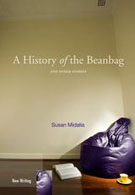 | Susan Midalia A HISTORY OF THE BEANBAG AND OTHER STORIES University of Western Australia Press, 173 pp. Source: review copy Review by Perry Middlemiss |
Short story collections are a strange concoction for most of us. Science fiction and fantasy readers are well accustomed to the form, with a number of monthly magazines and an array of original and reprint anthologies appearing each year. But readers of literary fiction will not be so familiar, which might well go a long way to explaining the dearth of them.
Maybe readers expect too much of them, maybe they really long for a novel, or maybe they just can't understand what the writer is trying to do. The novel is easy enough(!): it's a literary form that allows a writer to explore their desired story/theme/characterisation for as long as they want or need. They can just keep going until they've reached an end. But short stories don't allow that level of freedom and I wonder if, subconsciously, the reader is aware of that and maybe thinks they are not going to receive full "bang for their buck". If that's the case then I think the reader is approaching
the short story form in the wrong way. Maybe if they read A History of the Beanbag and Other Stories they might just change their minds.
There are three major short story forms in my view: the novel synopsis, the linear tale and the mood piece. The title story, "A History of the Beanbag", falls definitely into the novel synposis category. Some will see it as a straight linear tale, and here we can read it that way, and still look at what the story might have become in another context, rather than merely examining its surface. After a brief introduction to the beanbag and its history, we meet Robyn, a university student living in a sharehouse and looking for some cheap comfortable furniture in the early 1974. Needless to say the beanbag is the obvious choice, as it was for me some 30-odd years ago. There is a brief description of the changing relationships within the sharehouse, mainly involving the new woman Kathy, before we jump to 1983. Now it's Kathy's turn to be out purchasing a beanbag. Three years later and Kathy's marriage to Glen, from the original sharehouse, is falling apart. And 8 years later, in 1994, Robyn and the now-divorced Kathy get reacquainted. Beanbags hover in the background all through this story.
Not much to it is there? At least not at first look. Yet if you look deeper you'll see that there is a full novel lurking beneath the surface of this story. Normally that would ruin it for me. But not with this story. Something lifts it above its superficial level and you get a glimpse of what might have been as well as the enjoyment of the piece at hand. It's quite
remarkable and an excellent choice to lead off this collection. While the rest of the works here don't quite rise to these standards, there is certainly enough to interest any reader. The topics are usually domestic suburbia and they leave you with the feeling that the author has worked and re-worked them for some time, only allowing them out into the world when they are well and truly ready.
Susan Midalia has a lot of writing talent. On the evidence of this collection I'd be interested to see how she handles the novel form. Quite well I suspect.
